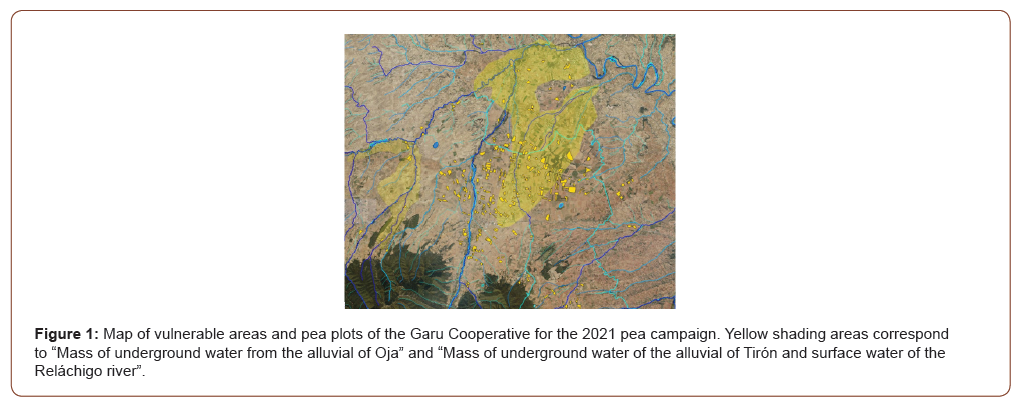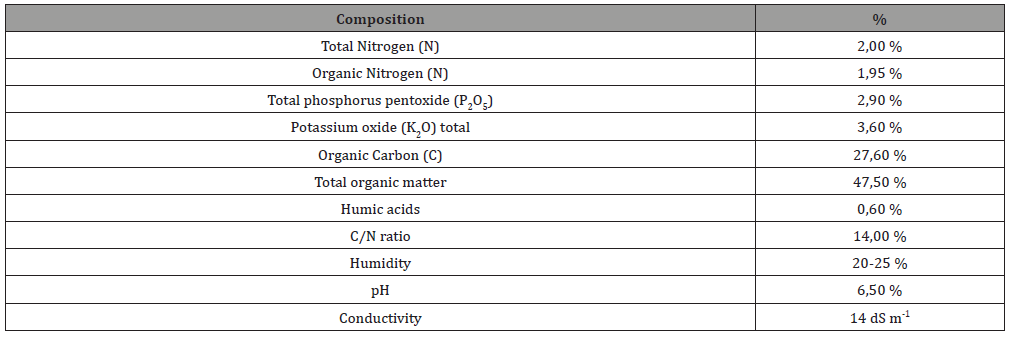 Mini Review
Mini Review
Reduction of Nitrogen Fertilization in Green Peas by Using Vegetable Compost
Óscar Zuazo Velasco1, Francisco J Castillo Ruiz2*, Nicolás Riaño Para1, Roberto Valencia Omatos1 and Julia Arbizu Milagro2
1Garu Cooperative Society, Ctra, de Logroño, Santo Domingo De La Calzada, Spain
2University of La Rioja RG “Technology, Engineering and Food Safety”, Faculty of Science and Technology, C/ Madre de Dios, Spain
Francisco Jose Castillo Ruiz, University of La Rioja RG “Technology, Engineering and Food Safety”, Faculty of Science and Technology, Spain.
Received Date: April 19, 2021; Published Date: April 26, 2021
Abstract
Nitrate pollution represent an increasing threat to many superficial and soil water masses. European laws determine Nitrate Vulnerable Zones in which nitrate fertilization was restricted to reduce water pollution risks. In order to avoid excessive soil nitrogen content, that could cause pollution through leaching or runoff. 282 plots of green pea were selected to take soil samples to analyze macronutrient content (Nitrogen, phosphorous and potassium). Depending on soil macronutrient content, 185 plots were proposed to be fertilized only with 1000 kg ha-1 of vegetable compost because previous soil analyses provided adequate levels of macronutrients. The other plots were fertilized with 500 kg ha-1 of mineral fertilizer considering that previous analyses showed low levels of at least one macronutrient.
Introduction

Nitrate pollution, both in surface and ground water, represents an increasing problem worldwide, due to its consequences both for the environment Zhang, et al. [1] and for human health Townsend [2]. Every year, Garu Cooperative sows more than 1,300 hectares of green peas for the deep-freezing industry, mainly in La Rioja Alta area. In some areas of this region there is an important problem of contamination by nitrates of agricultural origin, having been defined two Nitrate Vulnerable Zones (NVZ) according to Decree [3] of the regional government of La Rioja (Spain) (Figure 1).
Materials and Methods
For the 2021 campaign, soil analyses were carried out in 90% of the 282 green pea plots planted by the cooperative’s members. When the analysis provided medium or high levels of macronutrients (N, P, K), the plot was proposed to be fertilized only with vegetable compost. The compost had a low nitrogen content (Table 1) and it was presented as granulated solid to facilitate fertilizer spreading using common centrifugal fertilizer spreaders.
Table 1: Vegetable compost composition.

It is important to point out that compost maturity should be checked to ensure high quality organic fertilizer. An immature compost with a C/N ratio greater than 25 or 30 could produce depressive effects on plants by reducing oxygen concentration at the root zone, as well as blocking soil nitrogen in mineral form. Selected compost for these plots accomplishes this feature having a C/N ratio lower than the exposed threshold. Plots planted with green peas could be fertilized using mineral fertilizer (8-8-20 %, N-P-K) at a dose of 500 Kg ha-1 if soil analysis provided low levels of any macronutrient (N, P or K). Otherwise, if soil analysis provided adequate level of macronutrients 1000 Kg ha-1 of compost was spread. In both cases, a single application is made prior to sowing. The compost was used in 185 of the 282 plots (66%).
Result and Discussion
Since 2016, 1106 soil analyses were performed by Garu cooperative. These analyses shown high or very high levels of macronutrients: Nitrogen (N), average 16,8 mg Kg-1 (range from 1 to 264 mg Kg-1), Phosphorous (P), average 51 mg Kg-1 (range from 4.9 to 234 mg Kg-1 ), and Potassium (K), average 226 mg Kg-1 (range from 2.6 to 747 mg Kg-1). However, these analyses provided medium or low levels of organic matter in most of the plots, average 1.8 % (range from 0.17 to 5.5%). For this reason, the cooperative technicians decided to replace the traditional mineral fertilizer with vegetable compost in the 2021 campaign. Vegetable compost contained a lower macronutrients content in its composition than mineral fertilizer, and compost often showed slower N mineralization than mineral fertilizer which could help to reduce nitrogen leaching risk when N demand of crops are low [4,5]. This replacement was carried out with the aim of reducing N applied to soil, while the levels of soil organic matter should be increased. The harvest of 2021 campaign will be carried out by the own cooperative’s pea harvesters (Ploeger EPD 540) at the optimal maturation stage. Yield, tenderness degree, and yield value, will be also recorded by GARU cooperative technicians, comparing the results provided by mineral fertilized plots and compost fertilized ones.
Acknowledgement
None.
Conflict of Interest
No conflict of interest.
References
- Zhang X, Davidson EA, Mauzerall DL, Searchinger TD, Dumas P et al. (2015) Managing nitrogen for sustainable development, Nature 528(7580): 51-59.
- Townsend AR, Howarth RW, Bazzaz FA, Booth MS, Cleveland CC, et al. (2003) Human health effects of a changing global nitrogen cycle. Frontiers in Ecology and the Environment 1: 240-246.
- Decree (2021) of 10th of March, that modifies Decree 127/2019, of 12th of November, in which nitrate vulnerable zones are declared and it is approved the intervention program in the region of La Rioja.
- Masunga RH, Uzokwe VN, Mlay PD, Odeh I, Singh A, et al. (2016). Nitrogen mineralization dynamics of different valuable organic amendments commonly used in agriculture. Applied Soil Ecology 101: 185-193.
- Ranasinghe RASN, Marapana RAUJ (2018) Nitrate and nitrite content of vegetables: A review. J Pharmacognosy and Phytochemistry 7: 322-328.
-
Óscar Zuazo Velasco, Francisco J Castillo Ruiz, Nicolás Riaño Para, Roberto Valencia Omatos, Julia Arbizu Milagro. Reduction of Nitrogen Fertilization in Green Peas by Using Vegetable Compost. World J Agri & Soil Sci. 7(1): 2021. WJASS.MS.ID.000651.
-
Nitrogen, Fertilization, Green Peas, Vegetable compost, Reduction
-

This work is licensed under a Creative Commons Attribution-NonCommercial 4.0 International License.






